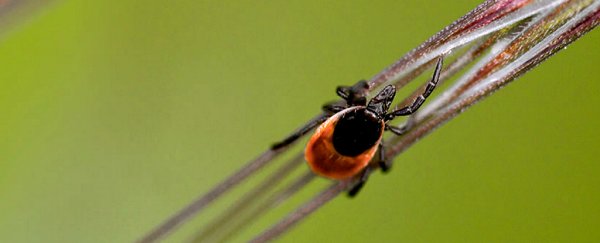On paper, Lyme disease is a straightforward enough condition - it's a disease spread by the tick-borne Borrelia bacteria that can cause a distinctive 'bullseye' rash, fever, headache, and fatigue.
But in practice, it continues to confound patients and doctors alike. Because while the vast majority of people are treated after a short course of antibiotics, a small but undefined percentage of the 329,000 US patients infected every year will go on to suffer symptoms for months or even years afterwards.
These lingering symptoms are referred to as 'post-treatment Lyme disease syndrome' (PTLDS) or less formally 'chronic Lyme disease', and there's an ongoing (and very heated) debate over whether this is an actual condition or not, and how to treat it.
But now long-forgotten research notes from the scientist who originally identified Borrelia as the cause of Lyme disease have resurfaced, and they suggest that a potential secondary Lyme bacteria could be causing some of these confusing symptoms, and could explain why the disease isn't always so easy to treat.
This new lead has gotten researchers excited that they could finally find a way to explain the difference in response in Lyme disease patients.
But let's step back a second here to go over some of the background info. In the late 1970s, just 18 months before Borrelia bacteria was named the cause of Lyme disease, tick expert Willy Burgdorfer was confident that he might have found the culprit - a different tick-borne bacterium called the "Swiss Agent" - now known as Rickettsia helvetica.
By 1981, Burgdorfer had changed his mind, and was convinced that Borrelia was behind Lyme disease. In 1982, he published his results in a seminal paper in Science that set the foundation for our understanding of Lyme disease.
Burgdorfer died in 2014, but medical journalism site STAT has recently been given the archives of his old research papers, including letters, lab notes, and blood test results - and they suggest that he never quite gave up on the idea that the Swiss Agent bacterium could be involved in some way with Lyme disease.
"Scientists who worked with Burgdorfer, and reviewed key portions of the documents at STAT's request, said the bacteria might still be sickening an unknown number of Americans today," writes Charles Piller for STAT.
In response to the new evidence, the CDC is now using molecular techniques to look for evidence of the Swiss Agent bacterium in 30,000 samples from people suspected to have contracted tick-borne illnesses - something that will take several years to get results on.
So here's what was in Burgdorfer's notes that was so compelling. First of all, there was blood work showing that at least a dozen Lyme patients from the late '70s had been infected with Swiss Agent, and at least six others might have been infected with the bacteria.
The records didn't make it clear how many Lyme disease patients had been tested overall, but it was enough for Burgdorfer to follow up with more trials. Those second set of trials contained some inconsistencies, and led Burdorfer to pursue Borrelia instead as the leading culprit for Lyme disease.
But he wasn't entirely convinced. Burgdorfer's notes also contain a letter he'd written to a Swiss colleague just a few months after discovering Borrelia which asked: "Do you feel that Rickettsia suisse [the name given to the Swiss Agent at the time] is the etiologic agent of (Lyme)? If so, how would you go about proving this?"
Early, handwritten drafts of that seminal Science paper also contained references to Rickettsia bacteria, which didn't make it into the final published version.
And researchers also found a handwritten note by Bugdorfer on top of a stack of documents saying: "I wondered why somebody didn't do something … then I realised that I am somebody."
"While the evidence is hardly conclusive, patients and doctors might be mistaking under-the-radar Swiss Agent infections for Lyme, the infectious disease specialists said. Or the bacteria could be co-infecting some Lyme patients, exacerbating symptoms and complicating their treatment - and even stoking a bitter debate about whether Lyme often becomes a persistent and serious illness."
Adding to the evidence is the fact that in Europe, experts have noted that Lyme and Rickettsia helvetica have co-infected patients in the past.
Rickettsia helvetica can be easily treated by antibiotics, but if it goes untreated, it can share serious - and sometimes persistent - symptoms with Lyme disease, Piller reports, such as fatigue, facial paralysis, muscle weakness, and severe headaches.
Given that right now researchers can't understand why some people respond to Lyme disease antibiotics and some don't, the potential of a secondary cause of the disease - or a co-infection - is incredibly promising.
In addition to the CDC's screening project, a Columbia University researcher, Ian Lipkin, is currently looking for other types of viruses living in ticks that spread Lyme, and is now seeking funding to expand his research to also hunt down the Swiss Agent.
"Everyone wants to get to the bottom of this," Lipkin told Piller. "All of this is critical to … finding out why some people respond to antibiotics and some people don't, and whether or not the antibiotics being used are appropriate, and trying to find ways to link different bacteria and different viruses to different syndromes."
Only time will tell whether we've been overlooking the Swiss Agent and its role in Lyme disease all this time. But either way, thanks to these old research notes, we now have the chance to get a better understanding of a disease that infects so many people each year, and that's valuable in itself.
